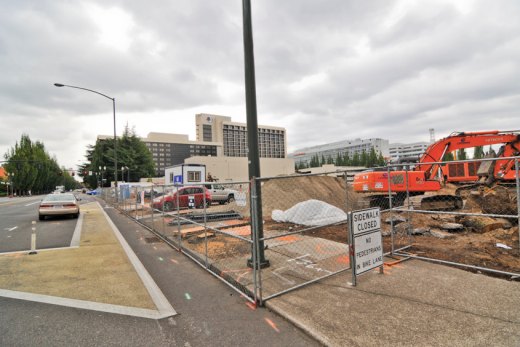
(Photo © J. Maus/BikePortland)
Dozens of new apartment buildings intended for low-car Portlanders are popping up across the inner east side, but the one where work just started two weeks ago will be the biggest one of all.
With 657 apartments stacked into 21 stories and 44,000 square feet of retail space below, the Lloyd Blocks project, sometimes referred to as “the superblock,” is the Lloyd District’s best chance in years to shake off its reputation of sterility and change itself into a “16-hour district” with street-facing bars and restaurants that stay open after 6 p.m.
And because the Lloyd Blocks will include only one residential auto parking space for every two apartments, they’re also a $250 million bet by a major California landlord, American Assets Trust, on the long-term marketability of low-car life in Portland.
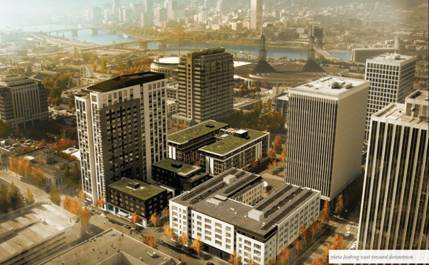
When it opens in 2015, the project will finally justify one of TriMet’s least explicable MAX stops, at NE 7th Avenue. It’ll give a major boost to the eastside streetcar line, whose tracks were rerouted northward just so they could stop at this project’s front door. And it’ll up the pressure for a new bike-friendly crossing of Interstate 84 that could create a neighborhood greenway on NE 7th and SE 9th Avenues.
If the project lures a “specialty grocer” to the southwest corner of NE 9th and Multnomah, as its developers think they can, the project could become a new main street for the rapidly growing Kerns and Eliot neighborhoods — but only if residents are willing to cross Interstate 84 and the auto-oriented Broadway-Weidler couplet to get there.
This is why, with bulldozers already at work, it’s especially strange that so few people seem eager to talk about this massive project.
“There is virtually no coverage by any news source on the project, and precious little info available from [the Bureau of Development Services],” said Craig Harlow, who lives and works near the Lloyd District and often uses bikes to get around the area with his four children. Harlow has tried to raise objections to what he describes as a “dead block face” along 9th Avenue that developers have requested to build despite a city standard that at least half the block should have street-facing windows.
“This neighborhood is particularly impacted by dead block faces, all around the DoubleTree Hotel, along most of the length of the Lloyd Center Mall on Multnomah, around most of the Lloyd Center Tower and the BPA building,” Harlow wrote in a June email. “They contribute to a ‘just keep moving’ message to pedestrians that provides a welcome environment for drug dealing and drive-fast environment for cars.”
Kara Fioravanti, a BDS staffer listed as a contact on the project, didn’t respond to multiple requests for information over the last three weeks. (In the meantime, the appeal window for a proposal related to the project expired.)
The Lloyd Transportation Management Association, a nonprofit with a regional mandate to reduce car dependence in the Lloyd District, said Tuesday that it has no comment on whether 657 new apartments on a single large block will increase the need for a more complete bike network in the area.
As we reported in 2011, real estate professionals associated with the Lloyd Blocks project essentially vetoed a consultant’s recommendation that NE Holladay Street should be the neighborhood’s main east-west bikeway, instead endorsing a plan to re-allocate lanes on NE Multnomah in order to create protected bike lanes. On Multnomah, thanks in part to advocacy from Harlow and others, the result isn’t bad at all. But if human-oriented streets fall by the wayside in the Lloyd, will the Lloyd Blocks ever successfully bring Portland’s most boring neighborhood to life?
— The Real Estate Beat is a weekly column. Read more here.


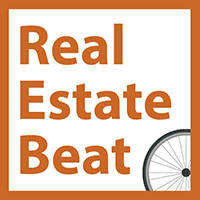
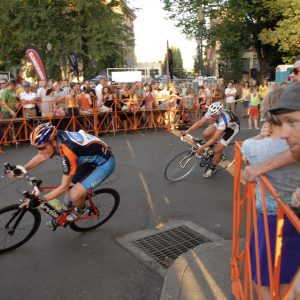
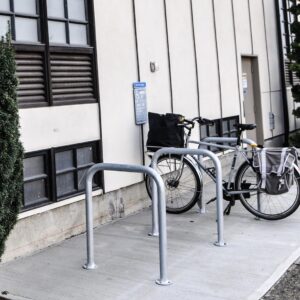
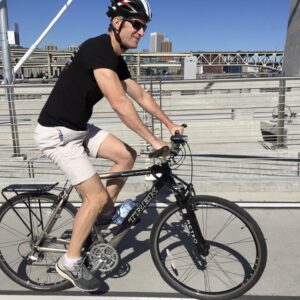

Thanks for reading.
BikePortland has served this community with independent community journalism since 2005. We rely on subscriptions from readers like you to survive. Your financial support is vital in keeping this valuable resource alive and well.
Please subscribe today to strengthen and expand our work.
Thank you for revealing what it is, because it’s been very mysterious.
I ride up and down Multnomah every day and have been gobsmacked at the sheer magnitude of the project, and yet I haven’t spotted any signage saying “Future Home of Blah-Blah,” or a visualization, or anything. That whole stretch of Multnomah has a weird, unappealing feeling (though the new bikeway has mitigated that a little). I hope this project livens the place up.
Not GOBSMACKED! Say this isn’t true!
The real danger here is if the development gets built, but fails because the rest of the neighborhood remains resolutely car-oriented.
“See,” critics could easily respond, “we *told* you low-car development doesn’t work.”
With 1-3% vacancy rates in east Portland, I don’t think they are going to have problems filling the place, especially if they get something like a grocery store on the ground floor.
Even if they don’t get a grocer there, there is a Safeway within walking distance. And supposedly another small Japanese grocer very nearby too (I have not been to it, though). Of course there are plenty of shops in the mall caddy-corner – but there are even more restaurants and little boutiques on Broadway itself.
Craig Harlow has legitimate concerns about the block faces, though. Even on blocks without ‘dead walls’, there is a sense of emptiness. Several of the office buildings in the neighborhood are set back away from the street, kind of 60’s office park style, and so on the sidewalk it feels like there is not much going on.
Make they could walk directly across the street to the Lloyd Farmer’s market on tuesdays.
I dunno, I see where you’re coming from, because the neighborhood definitely can LOOK foreboding, but I live very near to the Lloyd Center (in Sullivan’s Gulch) and I think it’s way less intimidating to bicycles and pedestrians than its rap. There’s quite a bit of stuff within walking and cycling distance, a decent (not great, but better than lots of places) route over Banfield, Tillamook within shouting distance, close to the Esplanade, yadda yadda yadda. As much as people rag on the mall, and I acknowledge it ain’t pretty or welcoming, but if you live nearby it’s as convenient as all hell from a walkability perspective.
I think this is great, but the ground-breaking has been particularly annoying since I work in the Lloyd district. There’s been a huge amount of dust kicked up – so much that it hurts my eyes when I bike down Lloyd Boulevard.
There’s also the matter that the construction zone’s footprint has increased the distance I have to walk to the Fuego cart, but that’s really a First World Problem.
Good north south connectivity here would be a nice outcome.
Kudos to Harlow and others for pushing for development that supports a vibrant, walkable urban street scape. We need more such voices everywhere. Construction of “dead block faces” seems to be a chronic failing of large public and private (corporate) developers. Wasting rather than embracing the street frontage is such a lost opportunity and can really squelch street level vibrancy and neighborhood livability.
Two other offenders I’d like to call out:
1. Portland Community College Cascadia Campus’s lackluster development along North Killingsworth. So far, most their new buildings feel like castle walls from a street corridor that has such potential to be more vibrant and pedestrian. PCC should be doing more to support community livability with its tax payer financed construction.
2. The new New Seasons on Williams is another total waste of both density and street frontage: the store design better fits a suburban setting. They have repeated the less-than-pedestrian-unfriendly design of their Arbor Lodge store (which is right along the Yellow Line MAX). You would think the “friendliest store in town” would know better.
I am venting… but the deadening effect of projects in places with so much potential and constructed by entities (PPC and New Seasons) that should know better is very disheartening.
Jim
I agree totally that the new New Seasons on Williams is meh.
They could have put rooftop parking above it, as they did with their Hawthorne location, and freed up an ENTIRE city block. Or they could have built office units / apartments above.
As it stands, the one-story store and huge parking lot looks tacky, rather like a cheap strip-mall grocery outlet…
Also, notice how none of the New Seasons stores (AFAIK) are built for mixed uses? They use the same style on Division and Williams as they do in their car-heavy suburban locations like Cedar Hills and Progress Ridge. Even Orenco, the area’s prime example of mixed use new urbanism, gets the standard suburban treatment with a parking lot out front and nothing on top.
It was worse at the Abor Lodge store. New Seasons founder Brian Rohter personally convinced the city and the neighborhood (desperate for a grocery store) to transfer the housing density on the site to another part of the city in order to put a parking lot along the street frontage next to a light rail stop!
Hence why the specialty grocer here wont be New Seasons.
There’s another New Seasons going in on the old Albina Fuel site, west of 33rd and between Broadway and the freeway. It’s going to be mixed used, with apartments and a parking structure… http://bikeportland.org/2012/09/19/new-seasons-market-coming-to-ne-32nd-and-broadway-77606
I couldn’t agree with you more on PCC. What a waste of potential! They’ve really served to hamstring the potential vibrancy of the rest of the street.
Good-old local New Seasons seems to be much more timid about embracing mixed-use design compared to big national chains like Whole Foods, Safeway, and Target. I wonder why this is the case.
The great thing about a surface parking lot is that it serves as a land bank for higher-intensity uses in the future as the market demands it.
I live in this hood, and am similarly perplexed by the lack of news coverage of this project. It is really hard to find any info on it.
As a total sidenote – if I emailed a City staffer multiple times in three weeks requesting info on a project they managed, and they didn’t get back to me, I would email the Mayor’s Office to complain. City staffers are accountable to us – the public – I would not tolerate a no-response from a City employee, ever.
We visited this site on your ‘The Rent Is Too Damn High’ ride during Pedalpalooza, Michael Anderson. My question now, as it was then, is if this mega-project is going to include onsite affordable units (at least 15% below city wide average)?
True affordability is a crucial issue for people struggling to find housing, and I hope if you can find more details on this project that this information can be included.
I wouldn’t expect new construction like this to be affordable especially, unless the city has mandated a subsidy for some units. But with residential rental vacancy rates at around 2% in all of inner NE/SE portland, landlords are going to be raising rents at older buildings, unless there is new supply. By building these new apartments, which will likely rent at the higher end of the scale, a few vacancies will open up in older buildings. This will slow the rise of rents at the lower end, as well.
Rather than providing more subsidized housing for a few families, the city should make it easier to build new housing at a moderate cost, through-out the city. That save a little on rent for thousands of people living in existing buildings, who are otherwise facing rising rents, while providing shiny new apartments for all the people who want to move here.
Wade Lange of Langley Investment Properties, the property manager, told me he’s still waiting for the configuration of units himself. My understanding, however, is that there’s no particular plan to provide any of these units below market cost.
Classic real estate bubble formation. 2008: single family home bust
2010: overbuilt condos sell for 75% off, 2015: apartment vacancy rates at 6%, maintenance declines, market saturated with undesirable units.
Never underestimate the lemming like behavior of real estate developers.
Hopefully rising interest rates will slow them down.
TODAY: http://www.greenwichtime.com/news/article/MAX-train-lifted-to-rescue-woman-pinned-beneath-4789160.php
In my opinion, MAX gets up way too much speed here to travel just two blocks in-between stops. Totally inappropriate for a dense, urban, pedestrian-heavy, livable-streets kind of environment.
Unless their policy changes to run at under 10 MPH inside the central city, they’re going to see a half-dozen or more of these per year once 637 new apartments and 1000 people take up residence at this exact location.
http://www.wpcwalks.org/>/a>, can we hear from you on the Lloyd Blocks project?
Because the MAX isn’t slow enough between Lloyd Center and Goose Hollow? I’d rather combine NE 7th Ave and Convention Center stations before we degrade travel times further. People need to be responsible for their own safety in oft-chaotic urban settings. Why not mandate all cars traveling on Holladay to go no faster than 10 mph too?
Reza, I understand your point, and I think the slow crawl of the MAX through downtown is excruciating–however, it suits the needs of tourists. They’d do us all a favor by routing a separate MAX line around downtown, to connect east and west sides more efficiently, but until then…
And I know that you know that cars traveling 20 mph can stop in a tiny fraction of the distance required for stopping a 20 mph MAX.
I’m also surprised by this statement: “People need to be responsible for their own safety in oft-chaotic urban settings.” I don’t assume that you mean that the city should NOT manage street safety by improving traffic control techniques–so what do you mean?
Thanks Craig, it was in response to your comment “Unless their policy changes to run at under 10 MPH inside the central city, they’re going to see a half-dozen or more of these per year once 637 new apartments and 1000 people take up residence at this exact location.”
I don’t see the evidence of this at all. MAX runs on pre-empt signalling in the Central City where it has dedicated (but not separated) ROW. I don’t know the details of this case, but unless the MAX operator completely blew through the yellow horizontal aspect (which means stop), then this woman got hit because she wasn’t paying attention. According to KATU, she was trying to cross at the mid-block crosswalk between 7th and 9th, saw that an eastbound train was stopped and thought it was safe to cross, and stepped in front of an arriving westbound train, which means that it was already decelerating. She would have gotten hit anyway by 100,000 lb train regardless of its speed, and who knows if she would have survived the collision.
So, she unfortunately failed to notice her visual surroundings, and the results were tragic. If people obey the laws, and are vigilant of their surroundings at all times, then accidents like this won’t happen. We all need to be defensive drivers, defensive cyclists, and defensive pedestrians.
And surely you don’t mean that we should design the MAX for the needs of out-of-town tourists, instead of everyday local commuters. I thought that was what the Streetcar was for? /snark
*like*
There’s no signal for MAX trains crossing an unsignalized crossing such as the mid-block crossing where this woman was hit. I used to work at this location and have used this crossing 1000’s of times. I feel much, much safer crossing the MAX tracks at this location than at the signalized intersection of 7th and Holladay one block away where cars make all sorts of illegal turns. From what I read on TriMet and City Police websites, it seems the pedestrian was videotaped looking at the parked MAX headed eastbound and neglected to look over her shoulder at the westbound directly, which is the direction she was also walking. This is why the pedestrian “z” crossings in East portland on Burnside channel pedestrians in such a way as to face both directions they are crossing. Very unfortunate and sad that this happened..
The MAX goes through this area less quickly than cars and they almost always honk their horns whenever two MAX trains approach from opposite directions. With the line of sight as good as it is on this straight stretch of road, I don’t think a reduction of speed is warranted.
With all of the noise at the construction site, MAX operators should be blowing their whistles multiple times, beginning well before reaching a stop.
Or people should just expect trains on tracks and first look.
Or **both** :^)
In my opinion-
One of the big problems to getting public input to a project like this is that the Lloyd District Community Association is not like any other neighborhood association in town because it is really a 501(c)6 business association like a TMA or other arrangement. They want residents to give input but in reality they have 2 residents on their board. There are neighborhoods nearby – irvington- sullivan’s gulch, eliot, kerns, but neighborhood associations tend to keep their minds focussed on their own turf. Additionally, the one venue for input on nearby areas is the neighborhood coalition offices- NECN or SEUL could have LDCA under them, but neither do, and as a result, there are very few residents keeping tabs on the huge projects that are destined to be built in the Lloyd area.
I think ultimately, the area in the lloyd district should seperate their business association from their neighborhood association and look to NECN to help them out with big issues like this one. otherwise they’ll be undermanned to deal with projects like this and the 20 to follow if this one works out
Agreed. The Lloyd District “Community” Association is not a residential neighborhood association. They are made up of primarily business owners and commercial property owners (I’m referring here to apartment building owners as commercial property owners), yet they were the only entity consulted by the city to represent the interests of residents in approving this project.
http://efiles.portlandoregon.gov/webdrawer/webdrawer.dll/webdrawer/rec/5936125/view/
But it’s not the city’s fault, exactly. There is currently no neighborhood organization to represent the interests of the thousands of residents of the Lloyd District.
If anyone is a current resident of the Lloyd District, and is activist-minded, consider organizing around the formation a real “Lloyd District Neighborhood Association”, and then petitioning the city to disassociate the Lloyd District Community Association from the city’s Office of Neighborhood Involvement.
http://www.portlandoregon.gov/oni/48280
In that first photo, why dont they temporarily close on the on street parking adjacent to the construction site, temporarily shift the bike lane to the parking lane and place a temporary sidewalk/walking lane where the bike lane was? Its BS to have no foot access on that side of the block.
They’ve closed MOST of the on-street parking along the block-face, but are utilizing that space for a new valet parking service, whereby cars are parked in the surface lot across the street. The eastbound bike lane along this block is now extra-hazardous.
This is a systemic Portland-wide problem, not just in Lloyd Center. See here: http://bikeportland.org/2013/08/27/photo-contest-portlands-worst-and-best-detours-92846
Until BDS and PBOT require contractors to preserve pedestrian access on the same side of the street during active construction projects, this won’t change.
I live in this neighborhood, and the first thing I did was try and join the local neighborhood association in the Lloyd District.
But… there isn’t one!! Buckman, and Boise-Elliott, and all the other neighborhoods surrounding the Lloyd have associations, but the Lloyd doesn’t.
There is NOT a lot of residential here at the moment – I would estimate about six or seven large apartment buildings in the entire district. But… that is still a thousand people or so.
I would love to see a neighborhood association formed for residents, NOT businesses. With the new infill going in, that might provide some impetus.
Oh, and as for the affordability factor… we just renewed our six month lease… in six months, the rent went up A HUNDRED BUCKS. AGAIN.
The Lloyd is ugly, but that does not mean it is rent controlled, or cheap.
I agree with Craig Harlow, and would add that a) BDS staff is too quick to give away “adjustments” to supposed “standards” for pedestrian-friendly design, and b) when a project such as this goes before Design Commission, they are also too easily swayed to give out adjustments that let the development have blank walls and otherwise be inhospitable to pedestrians. Being architects and builders, they sympathize with the developers, not the pedestrians.
New Seasons on Williams is a good example of things gone wrong for at least 2 reasons. One is that it is a one-story building where 6 stories could have been built. A tremendous waste of potential.
Two is that it has blank walls facing Vancouver and much of Fremont. I realize there’s a need to have “back of the house” functions. The answer is to bury them in the middle of the block and have retail storefront spaces for rent all along Vancouver, and along the remainder of Fremont. The Fred Meyer on Hawthorne had such spaces on it’s Hawthorne and on it’s 39th Ave (Chavez) frontages when it was built in the 50s. They were later filled in as FM expanded, and blanked out the walls. (Yes they added windows for a corner eating area, but still it’s not enough).
A giant first step would be to convince Charlie Hales to appoint different folks, folks who understand urban design, to the Design Commission. I’m afraid that it is in the sway of architects, who are excited about the abstract sculpture component of a building, and fail to grasp how a building should function and look to support an urban environment. (See the new tower approved for E. Burnside and NE 3rd!)
http://www.oregonlive.com/front-porch/index.ssf/2013/09/american_assets_trust_prepares.html
I guess someone finally asked the “O” to get into the game.